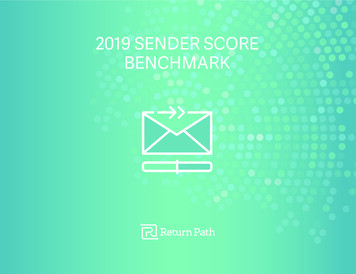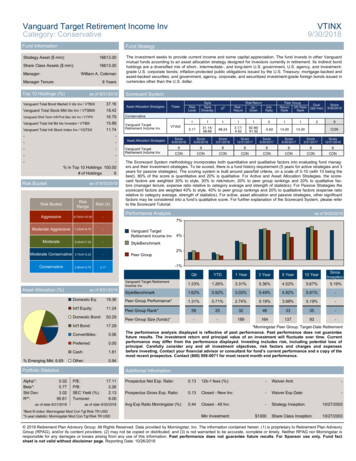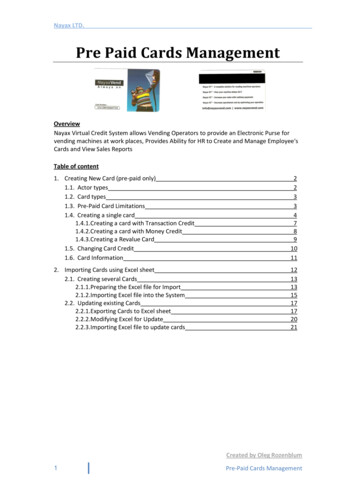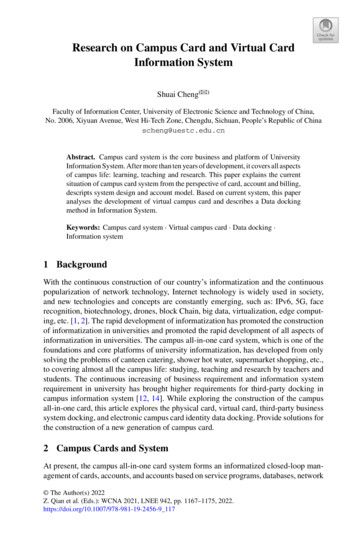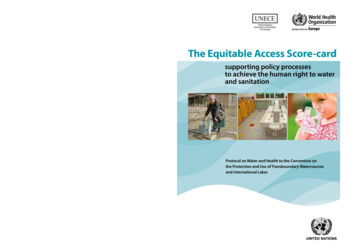
Transcription
The Equitable Access Score-cardsupporting policy processes to achieve the human rightto water and sanitationThe Equitable Access Score-cardThe Protocol on Water and Health specifies that in pursuing the aims ofaccess to drinking water and provision of sanitation for everyone, specialconsideration should be paid to ensure equitable access to these services forall members of the population.supporting policy processesto achieve the human right to waterand sanitationThe publication No one left behind: good practices to ensure equitableaccess to water and sanitation identified three critical factors in ensuringequitable access to water and sanitation: reducing geographical disparities;overcoming the barriers faced by vulnerable and marginalized groups; andaddressing affordability concerns.The Equitable Access Score-card presented in this publication buildsupon these three policy concerns. It is an analytical tool designed to helpGovernments and other stakeholders to establish a baseline measure of theequity of access to water and sanitation, identify related priorities, discussfurther actions to be taken and evaluate progress through a process of selfassessment.The publication contains recommendations on how to plan for the selfassessment and provides concrete examples of the benefits of using thescore-card in different settings. Parties to the Protocol and other stakeholdersare invited to use the Equitable Access Score-card to support the definition oftargets to bridge the existing gaps in access to water and sanitation and thusto achieve the human right to water and sanitation.Information ServiceUnited Nations Economic Commission for EuropePalais des NationsCH - 1211 Geneva 10, SwitzerlandTelephone: 41(0)22 917 44 44Fax: 41(0)22 917 05 e.orgDesigned and printed by the Publishing Service, United Nations, Geneva – GE.13-24456 – October 2013 – 1,162 – ECE/MP.WH/8Protocol on Water and Health to the Convention onthe Protection and Use of Transboundary Watercoursesand International Lakes
The Equitable Access Score-cardsupporting policy processesto achieve the human right to waterand sanitationProtocol on Water and Health to the Convention onthe Protection and Use of Transboundary Watercoursesand International Lakes
iiNoteThe designations employed and the presentation of the material in this publication do not imply the expression of anyopinion whatsoever on the part of the Secretariat of the United Nations concerning the legal status of any country, territory,city or area, or of its authorities, or concerning the delimitation of its frontiers or boundaries.Symbols of United Nations documents are composed of capital letters combined with figures.ECE/MP.WH/8
The Equitable Access Score-cardForewordEnsuring access to safe drinking water and sanitation forall members of the population, without discrimination,is an obligation for all governments. Everybody, whetherrich or poor, men, women and children, people living inurban and rural areas, having a suitable accommodationor not, people with physical disabilities or people living ininstitutions like prisons or hospitals, has the right to accessthese services.In 2005, the Protocol on Water and Health entered intoforce, committing its Parties in the pan-European regionto ensure that “equitable access to water, adequate interms both of quantity and of quality, (is) provided for allmembers of the population, especially those who suffera disadvantage or social exclusion”. The recognition ofaccess to water and sanitation as a human right by theUnited Nations General Assembly and the Human RightsCouncil in 2010, which was strongly supported by France,confirmed the obligation of governments to ensure thatwater and sanitation services are available, accessible, safe,acceptable and affordable for all without discrimination.Global targets and initiatives, such as the MillenniumDevelopment Goals and the commitment made bycountries at the United Nations Conference on SustainableDevelopment in 2012 to ensure the progressive realizationof the human right to water and sanitation, as well as theon-going reflection for the post-2015 agenda and thefuture Sustainable Development Goals, have restated theimportance of concentrating our efforts and financialmeans on implementing the human right to water andsanitation into practice.The continuous support from France to the activities onequitable access under the Protocol on Water and Healthpermitted the development of this new publication,which aims at supporting policy processes to achieve thehuman right to water and sanitation. The Equitable AccessScore-card presented in this publication is a contributionto the general reflection on how in practice to implementthese obligations and commitments. Defining policiesand targeted measures to improve the situation of accessto water and sanitation for all requires having a detailedknowledge of the current situation, in terms of existingpolicy instruments, financing strategies and programmes ofmeasures that contribute to reducing the gaps in access.The Equitable Access Score-card is an analytical selfevaluation tool that can help Governments and otherstakeholders to establish a baseline, discuss further actionsto be taken and evaluate progress. It builds on the findingsof the previous publication No one left behind: goodpractices to ensure equitable access to water and sanitation,which was launched in March 2012 at the sixth World WaterForum in Marseille, France. No one left behind identifiedwater resources availability, the urban-rural gap, access forvulnerable and marginalized groups and affordability as themain contextual challenges framing current inequities inthe pan-European region. The Equitable Access Score-cardcalls for information on policy options that may be chosenby countries to overcome those different challenges.We must encourage countries to voluntary engagein this self-assessment process, which can provide acomprehensive overview of the situation of equity ofaccess. This exercise has proven to bring many benefitsduring its pilot phase, for example in the City of Paris wherethe self-assessment exercise was carried out and provideduseful information for the formulation of the new nationaland Regional Plans for Health and Environment, especiallytheir equity dimension. As this exercise involves a broadrange of stakeholders, from the environmental to the socialand the financing sectors, it helps to identify the rightpartners and to initiate collaboration to undertake futurework. In addition, the outcomes of the self-assessment canbe used to help define an equity-related target under theProtocol, as well as related measures, based on a detailedassessment of the gaps to be bridged.I trust that this publication will stimulate countries touse the Equitable Access Score-card and support theprogressive realization of the human right to water andsanitation by supporting the inclusion of an equitableaccess dimension in existing policy processes.Ms Marisol TouraineMinister for Social Affairs and HealthFranceiii
iv
The Equitable Access Score-cardAcknowledgementsThis publication has been prepared in the framework ofthe United Nations Economic Commission for Europe(UNECE)/World Health Organization Regional Office forEurope (WHO/Europe). It would not have been possiblewithout the generous contribution of many Governments,individuals and international organizations and nongovernmental organizations.As the joint secretariat, we would like to particularlythank the members of the country project teams whopiloted the draft score-card:Ukraine: Irina Rudenko, State Sanitary and EpidemiologicalService; Iryna Baysarovitch, Taras Shevchenko NationalUniversity of Kyiv and Anna Tsvietkova, NGO MAMA-86France (Greater Paris Urban Area): Delphine Caamano,Ministry of Social Affairs and Health; Sylvain Rotillon andOdile Nieuwyaer, Mairie de Paris.Portugal: David Alves and Alvaro Carvalho, EntidadeReguladora dos Serviços de Águas e Resíduos (ERSAR).We are also most grateful to the local experts whocontributed to the pilot exercises by providing data andcomments.In developing this tool, we have greatly benefited fromthe comments, ideas and inspiration of the additionalmembers of the expert group on monitoring progressin achieving equitable access to water and sanitation:Serik Akhmetov, Ministry of Environment Protection,KazakhstanArmine Arushanyan, Ministry of Nature Protection, ArmeniaAlena Drazdova, Ministry of Public Health, BelarusFabien Dupuis, Ministry of Foreign Affairs, FranceDag Hongve, Institute of Public Health, NorwayTanja Knezevic, Institute of Public Health, SerbiaIngeborg Limbourg, Flemish Environment Agency, BelgiumYannick Pavageau, Ministry of Social Affairs and Health,FrancePierre Studer, Federal Office of Public Health, SwitzerlandDidier Allely, World Health OrganizationEmma Anakhasyan, NGO – Armenian Women for Healthand Healthy EnvironmentGalia Bardarska, Global Water Partnership for Central andEastern Europe (GWP CEE)Hélène Boussard, WaterLexMadoka Saji, Office of the United Nations HighCommissioner for Human RightsHenri Smets, French Water AcademyClaudia Wendland, Women in Europe for a Common Future(WECF)Oliver Schmoll and Enkhtsetseg Shinee, joint secretariat,WHO/EuropeFrancesca Bernardini, formerly of the joint secretariat,UNECENicholas Bonvoisin and Chantal Demilecamps, jointsecretariat, UNECEAdditional comments have been provided by: MartaVargha, Hungary; Julie Perkins, UN-Habitat; Karen Amlaev,WHO Healthy Cities Network, Xavier Maitrerobert, Aquafed.From UNECE, Cammile Marcelo and Katri Veldreprovided administrative support to the process. NadejdaKhamrakulova, Alisher Mamadzhanov and VolodymyrKebalo contributed to the finalization of the publication.The publication was edited by Christina O’Shaughnessy.Roberto Martin-Hurtado, UNECE consultant, was the mainauthor of the document.The joint secretariat gratefully acknowledges the fundingprovided by the French Ministry of Social Affairs and Health.v
vi
The Equitable Access Score-cardContentsForewordiiiAcknowledgementsvList of acronyms and abbreviationsviiiIntroduction1Chapter 1 EQUITABLE ACCESS TO WATER AND SANITATION5The challengeInternational obligationsSteering governance frameworksReducing geographical disparitiesEnsuring access for vulnerable and marginalized groupsKeeping water and sanitation affordable for allChapter 2 HOW TO USE THE SCORE-CARDHow to organize a self-assessment exercise and communicate the resultsPractical Guidance – Notes for filling the score-cardGlossary of key termsChapter 3 COUNTRY EXPERIENCES IN USING THE SCORE-CARD56667799121317France (greater Paris urban area)PortugalUkraine171819Chapter 4 THE SCORE-CARD21Country/Region ProfileSocioeconomic and sector dataInternational obligations on water and sanitationSection 1 Steering governance frameworks to deliver equitable accessto safe drinking water and sanitationArea 1.1Area 1.2Area 1.3Strategic framework for achieving equitable accessSector financial policiesRights and duties of users and other right-holdersSection 2 Reducing geographical disparitiesQuantitative information on geographical disparitiesArea 2.1 Public policies to reduce access disparities between geographical areasArea 2.2 Public policies to reduce price disparities between geographical areasArea 2.3 Geographical allocation of external support for the sectorSection 3 Ensuring access for vulnerable and marginalized groupsQuantitative information on vulnerable and marginalized groupsArea 3.1 Public policies to address the needs of vulnerable and marginalized groupsArea 3.2 Persons with special physical needsArea 3.3 Users of health facilitiesArea 3.4 Users of educational facilitiesArea 3.5 Users of retirement homesArea 3.6 PrisonersArea 3.7 Refugees living in refugee camps and centresArea 3.8 Homeless peopleArea 3.9 Travellers and nomadic communitiesArea 3.10 Persons living in housing without water and sanitationArea 3.11 Persons without access to safe drinking water and sanitation in their workplacesSection 4 Keeping water and sanitation affordable for allQuantitative information on affordabilityArea 4.1 Public policies to ensure affordabilityArea 4.2 Tariff measuresArea 4.3 Social protection measuresOverview of 1424344454546474849vii
viiiList of acronymsand abbreviationsCSOCivil society organizationERSAREntidade Reguladora dos Serviços de Águas e ResíduosEUEuropean UnionGDPGross domestic productNGONon-governmental organizationSEDIFSyndicat des Eaux d’Île-de-FranceSIAAPSyndicat Interdépartemental pour l’Assainissementde l’Agglomération ParisienneSSESState Sanitary and Epidemiological Service of UkraineUNECEUnited Nations Economic Commission for EuropeUNICEFUnited Nations Children’s FundWASHWater, Sanitation and HygieneWHOWorld Health OrganizationWHO/EuropeWHO Regional Office for Europe
The Equitable Access Score-cardIntroductionAccess to safe drinking water and sanitation is a human right that is part of the right to adequate standard of living, enshrinedin article 11 of the International Covenant on Economic, Social and Cultural Rights. It has been explicitly recognized by theGeneral Assembly of the United Nations and by the United Nations Human Rights Council. States are therefore legally boundto ensure access to water and sanitation for all and have to take steps toward the full realization of the right. To comply withthis obligation, they need to ensure that access to water and sanitation is equitable for all members of the population.Some people require special attention. For instance, people living in small rural communities, the homeless, or the urbanpoor that cannot pay the water bill. If no specific attention is paid to solutions focusing on those people who are difficult toreach, disparities in access to water and sanitation are likely to increase and will undermine our efforts.It is hard to believe that in the pan-European region in 2011, 19 million people lacked access to an improved source ofdrinking water and 67 million people lacked access to improved sanitation, resulting each year in many premature deaths.We find significant differences not just between countries but within countries, and these differences are not random. Forexample in one country, the poorest 40% of the population are over seven times less likely to have access than the richest20%. Access to water and sanitation remains a challenge in the pan-European region, with specific groups of the populationfacing real barriers in all countries.Existing legal and political commitments demand that we address inequities in access to water and sanitation. For instance,the Parties to the UNECE-WHO/Europe Protocol on Water and Health have committed themselves to ensuring equitableaccess to safe drinking water supply and adequate sanitation through accession or ratification of the Protocol. The 2010Parma Declaration on Environment and Health set a target for children as a vulnerable group:The pan-European region will “provide each child with access to water and sanitation in homes, child care centres,kindergartens, schools, health care institutions and public recreational water settings by 2020”.And countries in the pan-European region, working within the framework of the Protocol on Water and Health, are steppingup to the challenge. In 2012, the Working Group on Water and Health launched the publication No One Left Behind: goodpractices to ensure equitable access to water and sanitation in the pan-European region.Presenting policy options and good practices, the publication identifies three key challenges in relation to equitable access: Reduce geographical differences in the services provided Prevent discrimination or exclusion in access to services by vulnerable and marginalized groups Ensure financial affordability by users.The publication also points out that the strong linkages between the provision of water-supply and sanitation servicesdemands a holistic approach. Its overall message is that we have at our disposal the policy tools and the experience in usingthem to ensure that we can make strong advances towards universal access to water and sanitation.The current document presents an analytical tool that can help Governments and other stakeholders to establish a baseline,discuss further actions to be taken, and evaluate progress through a process of self-assessment. It also offers guidance onhow to use the analytical tool, based on the experience of three pilot exercises carried out in France, Portugal and Ukraine.1
2The tool takes the form of a score-card. It lists policy options, and the user is expected to provide and justify a score thatsummarizes the degree to which a number of selected policy options are being used. The score-card also calls for quantitativeinformation to contextualize the findings and describe the level of access to safe drinking water and sanitation. As a user ofthe score-card, you should feel free to adapt it to your own needs.The score-card can be used by any country, region, or city in the world to carry out a self-assessment. It has been designednot to enable comparisons between countries (or sub-national territories) but rather to allow a country (or a subnationalterritory) to compare its own different results over time.Although the score-card is not part of official reporting under the Protocol on Water and Health, the Parties to the Protocolare highly encouraged to use it to obtain a baseline analysis of the equity of access to water and sanitation, to identify relatedpriorities, to set targets to bridge the identified gaps and to evaluate progress.Achieving and keeping equitable access depends on a well-functioning water and sanitation sector. The score-card does nothowever focus on the general functioning of the water and sanitation sector. Nor does it address other circumstances thatmay impinge on access to equitable access and sanitation, such as water resources governance. The score-card focuses onselected issues and indicators that together can provide a solid overview of the situation of access to water and sanitationin terms of equity at different times.The process of self-assessment, as shown by the experience of France (Greater Paris urban area), Portugal and Ukraine, canenable the authorities to identify the right partners to undertake further work, help to initiate collaboration among authoritiesand between authorities and other stakeholders, and can generate input for policy processes. By involving a broad range ofstakeholders, the self-assessment can raise awareness and facilitate the development of a common understanding of equityof access to water and sanitation as well as creative thinking.Use of the score-card can help introduce an evidence-based and structured approach to the discussions among thestakeholders. This can allow the development of a “high resolution” situational analysis (including the identification ofexisting policies and ongoing activities, and show up any gaps between legal texts and on-the-ground realities) that can inturn enable an objective debate. The score-card can also help broaden the scope of the discussions and clarify the need forimprovements in information availability and reliability.The rest of the document is structured around four sections. Section 2 briefly discusses the challenges, dimensions andefforts required to ensure equitable access to water and sanitation. Section 3 provides guidance on how to use the scorecard: both strategic guidance on how to organize a self-assessment exercise as well as practical guidance on how to fill thescore-card. Section 4 presents the experiences of France (Greater Paris urban area), Portugal and Ukraine in using the scorecard. Section 5 presents the tool itself.
The Equitable Access Score-card3
4
The Equitable Access Score-cardChapter 1EQUITABLE ACCESSTO WATER AND SANITATIONThe challengeThe current inequities in access to safe drinking water and adequate sanitation require specific approaches. A person may lackaccess to safe drinking water and sanitation simply because there is no access to safe water and sanitation in the community,or due to the degradation of water resources (scarcity, pollution), but more commonly due to poor or no management ofwater and sanitation infrastructures. Or a person may have access but cannot afford to pay the water and sanitation billwithout having to cut down on the consumption of other basic goods and services.A community may have access to safe drinking water and sanitation, but those services (a) are not adapted to the particularneeds of certain groups (e.g. people with disabilities), (b) are not adequately available in institutions that those groups relyon (e.g. schools, prisons, refugee camps) or (c) certain groups (e.g. ethnic minorities, illegal settlers) may be denied access towater and sanitation due to intentional or unintentional discrimination practices.In the pan-European region, four contextual challenges frame the inequities to access: Water resources availability. The degradation of the quality of water resources implies that many towns andvillages that rely on local water sources do not have access to safe water, while water scarcity can deprive sometowns and villages from access altogether. Polluted water can be treated to make it suitable for drinking purposesand freshwater can be brought over long distances, but these technical solutions can entail prohibitive costs. Urban/rural gap and availability of water supply and sanitation infrastructure. Rural areas in the pan-Europeanregion have significantly lower levels of access to water and sanitation services than urban areas. Specific barriers faced by vulnerable and marginalized groups. People belonging to those groups do not enjoythe same kind of access to water and sanitation as the rest of society. The situation differs according to the group, asfor instance: (a) people with special physical needs (such as the disabled or the sick); (b) people who rely on publicfacilities (e.g. travellers or the homeless); (c) people who use facilities provided by institutions such as hospitals,schools, prisons or refugee camps or (d) people who live in unsanitary housing.5
6The Equitable Access Score-card Chapter 1 EQUITABLE ACCESS TO WATER AND SANITATION Affordability. This is a growing concern for all countries. For the poorest countries, either a large part of thepopulation is devoting a big share of their income to pay for water and sanitation services, or they will eventually befacing this situation as tariffs might increase to ensure financial sustainability. In EU countries, more stringent waterquality objectives and progress towards full cost recovery also mean that paying for water and sanitation services isbecoming a real concern for lower-income families.International obligationsThe human right to water and sanitation entitles everyone to water and sanitation that is available, accessible, affordable,acceptable and safe (Committee on the Economic, Social and Cultural Rights, General Comment 15 (E/C.12/2002/11),General Assembly resolution 64/292, Human Rights Council resolution A/HRC/RES/15/9). Some components of the rightto water and sanitation are deemed subject to progressive realization, but obligations such as of non-discrimination are ofimmediate effect. Positive discrimination measures might therefore be adopted to ensure access for all before improving theconditions of access for those who already enjoy it.Under the Protocol on Water and Health, Parties must ensure access to water and sanitation to all. As well as other keycomponents of the human right to water such as access to information, public participation and accountability provisions,the Protocol specifically commits its Parties to promoting equitable access to water and sanitation “for all members of thepopulation, especially those who suffer a disadvantage or social exclusion”. The Protocol provides a sound framework fortranslating into practice the human right to water and sanitation, in particular through setting specific targets and targetdates tailored to the country’s situation and capacity.States have to use the maximum of available resources towards the full realization of the right to water and sanitation. Atthe same time, both in relation to the application of human rights and the implementation of the Protocol, the internationalcommunity acknowledges a legal obligation of assistance and cooperation. Although considerable financial resources arealready being devoted by the international community to improving access to water and sanitation, there is still a need toincrease these contributions.Steering governance frameworksThe realization of the right to water and sanitation requires political commitment and long-term vision. Current national andlocal water governance frameworks are sometimes failing to deliver equitable access for the following reasons: (a) broadergovernance frameworks may limit or undermine efforts in the water sector; (b) weak water governance and managementresult in poor sector performance; and (c) current water governance frameworks are often “equity blind”.Yet, good water governance and management can go a long way towards achieving equitable access objectives. Examplesinclude transparency and access to information, inclusive participation of stakeholders in decision-making, incentives foroperators to improve efficiencies and keep costs down, and accountability and redress mechanisms effectively accessibleto all people.That is unlikely to be enough, however. Applying an “equitable access lens” will speed up progress. This requires a resultsoriented action plan, building on country-situation analysis and context-specific equity indicators.All water and sanitation stakeholders need to be engaged and roles and responsibilities identified and allocated. Water usersmust participate actively, and not only as beneficiaries. Transparency, access to information, education and participatorymechanisms must be institutionalized to ensure equitable and sustainable results. The participation of the members ofvulnerable and marginalized groups constitutes a real challenge in all countries and must be given particular attention. Wateroperators need to be more responsive to delivering equitable access, and local government and civil society organizationsneed to play a greater role.Reducing geographical disparitiesEven within the same country, the water service in different geographical areas can be very different. According to the JointMonitoring Programme of the United Nations Children’s Fund (UNICEF) and the World Health Organization (WHO), in 2011,access to improved water and sanitation solutions in rural areas in the pan-European region is lower than in urban areas.For example, in the Caucasus and Central Asia, 96% of the population living in urban areas have access to improved watersources against 79% in rural areas. In addition, in the WHO/Europe region, 96% of the urban households enjoy access topiped water in the home against 72% for rural households. This can be attributed not only to underlying cost structures butalso to political influence and decisions.
The Equitable Access Score-card Chapter 1 EQUITABLE ACCESS TO WATER AND SANITATIONReducing access gaps requires political, financial and technical efforts. International cooperation can play an important rolein closing these gaps by focusing support on the areas that each country has identified as lagging behind. Importantly,geographical disparities in access are not just a water-policy issue, but also a regional policy issue.Public policy has a fundamental role to play in reducing price disparities between geographical areas by: (a) targetinginvestment programmes and subsidies to areas with higher costs of service, (b) enabling cross-subsidization from highincome low-cost areas to low-income high-cost areas, and (c) promoting efficiency and rational prices through sectoralorganization reform and the use of information tools such as benchmarking and tariff reference values.Ensuring access for vulnerable and marginalized groupsHuman rights principles highlight the need to actively design water and sanitation policies that prioritize and address theneeds of vulnerable and marginalized groups. Water and sanitation for these groups is often a social exclusion issue, and notjust a water issue.Each of these groups has its own needs and faces different access barriers to achieve equitable access. Policymakers andimplementers must dedicate time and resources to identifying these groups, to reviewing whether they are being included,and to ensuring that their particular needs are taken into account. In many cases, adequate solutions require an integratedresponse, combining policies and ensuring collaboration across public agencies. The solutions also require targeted financialresources, but those are seldom very great in comparison with a country’s water and sanitation budget. The solutions mostlyrequire increased awareness and specific focus among policymakers and technical staff.Keeping water and sanitation affordable for allIn Western European countries, increases in water and sanitation costs (due primarily to higher wastewater treatmentrequirements) have been and will continue to be reflected in water and sanitation bills. In Eastern European countries, wherewater prices have been traditionally low, the water bill is likely to increase. Affordability is thus a common and increasingconcern in the pan-European region, and requires adopting a long-term strategy in each country. Otherwise, a major healthissue could arise, as people confronted with increases in the water price might turn to less expensive but less safe alternatives,such as private groundwater wells of questionable water quality.Affordability concerns
assessment and provides concrete examples of the benefits of using the score-card in different settings. Parties to the Protocol and other stakeholders are invited to use the Equitable Access Score-card to support the definition of targets to bridge the existing gaps in access to water and sanitation and thus


